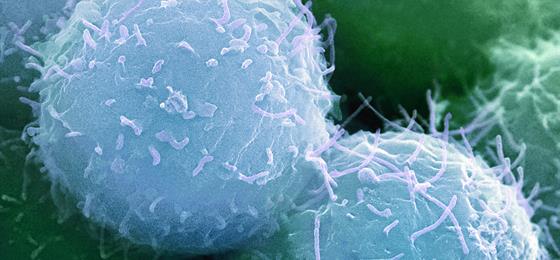Improving the body’s powers of regeneration

Stem cells can both trigger and cure diseases. During the past five years, the National Research Programme "Stem Cells and Regenerative Medicine" (NRP 63) has investigated their potential.
Diabetes, heart attacks, cartilage replacement, wound healing, brain tumours, Parkinson's disease: twelve research groups working on the National Research Programme “Stem Cells and Regenerative Medicine” (NRP 63) have examined various diseases. They have studied the way in which stem cells contribute to their development or can be used to provide better treatment for these conditions in future.
The Federal Council mandated the Swiss National Science Foundation (SNSF) to carry out NRP 63 in 2007. The aim was to explain the fundamental mechanisms of stem cell biology and regenerative medicine, train young researchers and promote leading-edge technology in Switzerland. The results of the research done between 2010 and 2015 have been compiled in a brochure that was published recently (link below).
Tumours from stem cells
“NRP 63 has produced a large number of extremely interesting results,” concludes Bernard Thorens, President of the NRP 63 Steering Committee. “This is borne out by the hundred-plus publications that have appeared in scientific journals, some of which are very prestigious.
The quality of the individual projects is also demonstrated by the fact that practically all of them are continuing beyond the end of NRP 63.” A total of 24 postdocs and 12 doctoral students were trained during the programme. Several groups are already in touch with biotech and pharmaceutical companies that are interested in utilising their results for the good of patients in the future.
The research groups looked at the important role played by the regulations of stem cells. The development of a stem cell into a blood cell, for example, is not controlled exclusively by genes. There are also overriding control mechanisms capable of switching several genes on and off at once. These have to be taken into account by developers of new medicines.
Research also focused on how tumours develop from stem cells. Two teams were able to show that the major danger does not arise from the stem cells themselves, but from immature intermediate forms that change back into stem cells and then go on to develop into tumours. “It's important to recognise the difference between benign and malignant growth,” says Lukas Sommer, a professor at the University of Zurich and leader of one of the NRP 63 projects. “Stem cells can only be used in medicine if we are able to control their growth.”
Replacing body parts
The group working with Pedro Herrera at the University of Geneva discovered that in mice the cells of the pancreas have an amazing capacity for transformation. If all the insulin-producing cells have been destroyed, they can develop again from related cells in the pancreas. This discovery could revolutionise the treatment of diabetes. Instead of injecting insulin, it may one day be possible to stimulate the patient's own cells to produce it.
In another project, the group working with Ralph Müller at ETH Zurich developed a new material to replace human cartilage. This nanocellulose could be used to reconstruct the visible outer part of the ear or to treat damaged knee cartilage. Populating it with cells from the patient would promote the development of natural tissue. The new material has already been tested in animals.
Most of the scientific publications generated by the twelve research projects are available to the public free of charge (link below).
NRP 63 in brief
The National Research Programme “Stem Cells and Regenerative Medicine” (NRP 63) promoted basic research, recruited talented individuals from developmental and cell biology, trained young scientists and increased the visibility of Swiss research in the international arena.
The Federal Council mandated the Swiss National Science Foundation (SNSF) to carry out NRP 63 and awarded it a budget of CHF 10 million. Between 2010 and 2015, twelve research groups based in Basel, Berne, Geneva, Lausanne and Zurich investigated new approaches to the treatment of various diseases.
Contact details
Prof. Bernard Thorens
President of the NFP 63 Steering Committee
University of Lausanne
Tel.: 021 692 39 81
E-mail: Bernard.Thorens@unil.ch
Florian Fisch
Science editor
Swiss National Science Foundation (SNSF)
Wildhainweg 3
3001 Berne
Tel.: 031 308 23 75
E-mail: florian.fisch@snf.ch
http://www.snf.ch/en/researchinFocus/newsroom/Pages/news-160201-press-release-nr…
http://www.nfp63.ch/en/Pages/Home.aspx Website of NRP 63 “Stem Cells and Regenerative Medicine”
Media Contact
All latest news from the category: Life Sciences and Chemistry
Articles and reports from the Life Sciences and chemistry area deal with applied and basic research into modern biology, chemistry and human medicine.
Valuable information can be found on a range of life sciences fields including bacteriology, biochemistry, bionics, bioinformatics, biophysics, biotechnology, genetics, geobotany, human biology, marine biology, microbiology, molecular biology, cellular biology, zoology, bioinorganic chemistry, microchemistry and environmental chemistry.
Newest articles

First-of-its-kind study uses remote sensing to monitor plastic debris in rivers and lakes
Remote sensing creates a cost-effective solution to monitoring plastic pollution. A first-of-its-kind study from researchers at the University of Minnesota Twin Cities shows how remote sensing can help monitor and…

Laser-based artificial neuron mimics nerve cell functions at lightning speed
With a processing speed a billion times faster than nature, chip-based laser neuron could help advance AI tasks such as pattern recognition and sequence prediction. Researchers have developed a laser-based…

Optimising the processing of plastic waste
Just one look in the yellow bin reveals a colourful jumble of different types of plastic. However, the purer and more uniform plastic waste is, the easier it is to…



